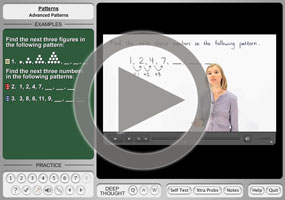Non-Mathematical Sequences
Method of Common Diff'sExamples of Common Diff'sRecursionsGeneral ExamplesMore ExamplesMore Non-Math
Purplemath
What is a non-math sequence?
A non-mathematical sequence is one for which the rule for the terms is not mathematical; its terms might not even be numbers. The rules will generally relate to culturally-specific things, such as the names (in English) of the months of the year or the days of the week.
Content Continues Below
Advertisement
I wouldn't mind if these non-math sequences were called "puzzlers", "brain-teasers", or "creative-thinking exercises", but they're not. They're assigned in math classes as though they were mathematical. Students tie themselves in knots trying to figure out the rule, only to find out that they've been punked.
This punking really bugs me, so I've started a collection here of spoilers, so you can short-circuit the process of frustration and find your answer here.
For instance:
- Find the next number in the sequence:
31, 28, 31, 30, ...
January has 31 days. February has 28 days. March has 31 days. April has 30 days. Since May has 31 days, then the answer is 31.
Of course, this only works in English.
- Find the next character in the sequence: J, F, M, A, ...
"January" starts with "J".
"February" starts with "F".
"March" starts with "M".
"April" starts with "A".
"May" starts with "M"
Again, this only works in English.
- Find the next character in the sequence: S, M, T, W, ...
"Sunday" starts with "S".
"Monday" starts with "M".
"Tuesday" starts with "T".
"Wednesday" starts with "W".
"Thursday" starts with "T"
This is another one that only works in English.
- Find the next character in the sequence: Z, O, T, T, F, F, S, S,...
"zero" starts with "Z"
"one" starts with "O"
"two" starts with "T"
etc, etc,...
"eight" starts with "E"
Imagine how difficult this might be for somebody who is still learning English.
Affiliate
- Find the next character in the sequence: A, E, F, H, ...
"A" is written with all straight lines.
"B" is written with curvy and straight lines.
"C" is written with curvy lines.
"D" is written with curvy and straight lines.
"E" is written with all straight lines.
"F" is written with all straight lines.
"G" is written with curvy and straight lines.
"H" is written with all straight lines.
"I" is written with all straight lines.
Seriously?
- Find the next character in the sequence: C, J, O, ...
This has nothing to do with math, and works by the same reasoning as the preceding example; it just takes the all-curvy-line letters, instead of the all-straight-line letters. So they're looking for "S".
- Find the next number in the sequence: 3, 3, 5, 4, 4, ...
"1" is spelled as "one", which has three letters.
"2" is spelled as "two", which has three letters.
"3" is spelled as "three", which has five letters.
"4" is spelled as "four", which has four letters.
"5" is spelled as "five", which has four letters.
"6" is spelled as "six", which as three letters: 3
Another of this sort is 3, 4, 4, 7, 10 (or 11), etc, which represents the numbers of letters (or characters) in the squares of 1, 2, 3, 4, 5, etc; namely, 1, 4, 9, 16, 25, etc. (The difference [the "or 11"] will come from whether or not hyphens are included.)
Content Continues Below
- Find the next two numbers in the following sequence: 2, 3, 3, 5, 10, 13, 39,....
This one looks mathematical, and it is, sort of. But don't look for an overall pattern, because there isn't one. This one is:
2 + 1 = 3
3 × 1 = 3
3 + 2 = 5
5 × 2 = 10
10 + 3 = 13
13 × 3 = 3
So the next steps will be "plus 4" and "times 4":
39 + 4 = 43
43 × 4 = 172
Then the next two numbes will be 43 and 172.
Affiliate
- Find the next two numbers in the sequence: 8, 5, 4, 9, 1,...
This one will be more obvious if I spell things out:
"8" is spelled as "eight", which starts with an "e".
"5" is spelled as "five", which starts with an "f" and an "i".
"4" is spelled as "four", which starts with an "f" and an "o".
"9" is spelled as "nine", which starts with an "n".
"1" is spelled as "one", which starts with an "o".
Golly, they're spelling the digit names and then listing the names alphabetically. So, hmm, "seven" and "six" would come next.
- Find the next number in the sequence: 7, 8, 5, 5, 3, 4, ...
"January" is spelled with seven letters.
"February" is spelled with eight letters.
"March" is spelled with five letters.
"April" is spelled with five letters.
"May" is spelled with three letters.
"June" is spelled with four letters.
"July" is spelled with 4 letters.
URL: https://www.purplemath.com/modules/nextnumb6.htm
Select a Course Below
Standardized Test Prep
Homeschool Math
© 2024 Purplemath, Inc. All right reserved. Web Design by ![]()




